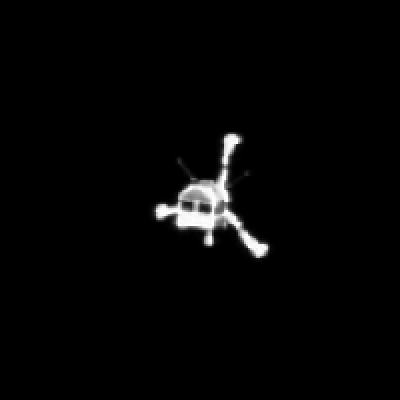
© 2025 Blaze Media LLC. All rights reserved.
Comet Mission in Danger? Images Show Probe Behind a 'Cliff' That's Causing a Major Problem
November 13, 2014
The European Space Agency's Rosetta mission successfully placed a probe on a comet for the first time in history Tuesday, but scientists are now in a race against time to save the lander before it loses all power.
Mission Director Paolo Ferri told the Daily Mail that the team is rushing to answer several questions before the lander Philae's 30-hour battery life ends after it set down in the shadow of a cliff, interfering with its solar panels.
 The Philae lander received some power from its solar panels, but parts of the lander were hidden in shadow by a cliff during Wednesday evening's surface telemetry transmission. (Image source: ESA)
The Philae lander received some power from its solar panels, but parts of the lander were hidden in shadow by a cliff during Wednesday evening's surface telemetry transmission. (Image source: ESA)
"If you look at the images we have at the moment, it looks like Philae is resting against a very irregular rock," Ferri said. "There is some speculation about it being in a hole … honestly, we have no idea, because we haven’t seen all the images."
ESA confirmed the probe Philae performed three landings on the surface of comet 67P/Churyumov-Gerasimenko during its attempt to latch on, including one "bounce" that topped half a mile.
"Rosetta’s lander Philae is safely on the surface of comet 67P/Churyumov-Gerasimenko, as these first two CIVA images confirm. One of the lander’s three feet can be seen in the foreground. The image above is a two-image mosaic," ESA said in a statement on its website.
Kuhn Gertz, a Philae systems analyst, said in a media briefing Thursday that the lander is currently relying on a primary and secondary battery.
"What we need to understand now is what does this position mean for us," Gertz said. "Of course the lander is relying on solar energy to operate over an extended period of time, we have primary and a secondary battery that we are using now. … We are getting less solar power than we planned for at the nominal landing site; we're receiving about 1.5 hours of sunlight [instead of] the six or seven we were aiming for."
But Ferri said even more important than where the lander ended up is whether or not Philae is resting on its side.

"What is more important is the attitude [angle] of the lander, and the clock is ticking for us to find this out," Ferri said.
Mission lead scientist Jean-Pierre Bibring stressed Thursday there are reasons to "open the champagne," including navigating for more than two hours in the open sphere around a "small [celestial] body."
Bibring said "we are in a revolution" with the achievements Rosetta and Philae have already achieved.
"Exploration is that adventure that happens only once in one's life ... we wanted to land, we landed ... and finally we bounced two times and finally stopped in a place that we haven't entirely located."
Bibring unveiled new images from Philae -- the first photos ever acquired from a comet -- and the shots reveal more information about the lander's situation.
"This is part of the problem ... we are not really well illuminated," Bibring said. "We are exactly below a sort of cliff." He said now that the team has these images they may be able to determine how to maneuver the solar panels to maximize power options.
Project manager Stephan Ulamec said the team has to be very careful about "activating any mechanisms" because the lander still isn't anchored to the comet, "but somehow just with the weight of the lander" it has come to rest in a "bizarre orientation" perhaps along the ridge of a crater.
 In a media briefing Thursday, ESA compared two views of the same image: the left side shows just the foot of the lander, and the version on the right blows out the foot but shows the cliff that is blocking the majority of the sunlight to the lander. (Image source: ESA)
In a media briefing Thursday, ESA compared two views of the same image: the left side shows just the foot of the lander, and the version on the right blows out the foot but shows the cliff that is blocking the majority of the sunlight to the lander. (Image source: ESA)
The team said the lander is "not in a dramatically different position" than they originally intended, but that they are still examining all of the data from Philae's images and the more than 80 systems on the lander that have already captured their assigned data sets, such as one system that was determine the magnetism of the surface of the comet.
Though the lack of sunlight does cause some problems for the Rosetta team, their Twitter mangers are keeping the tone light.
--
Follow Elizabeth Kreft (@elizabethakreft) on Twitter
Want to leave a tip?
We answer to you. Help keep our content free of advertisers and big tech censorship by leaving a tip today.
Want to join the conversation?
Already a subscriber?
more stories
Sign up for the Blaze newsletter
By signing up, you agree to our Privacy Policy and Terms of Use, and agree to receive content that may sometimes include advertisements. You may opt out at any time.
Related Content
© 2025 Blaze Media LLC. All rights reserved.
Get the stories that matter most delivered directly to your inbox.
By signing up, you agree to our Privacy Policy and Terms of Use, and agree to receive content that may sometimes include advertisements. You may opt out at any time.






